Townhomes vs. Houses: Key Differences Explained
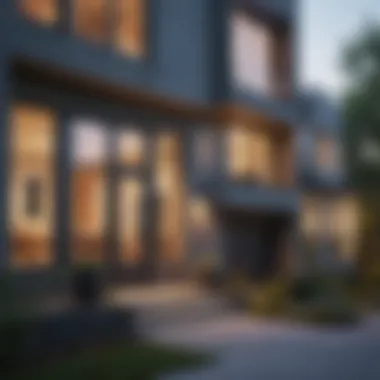
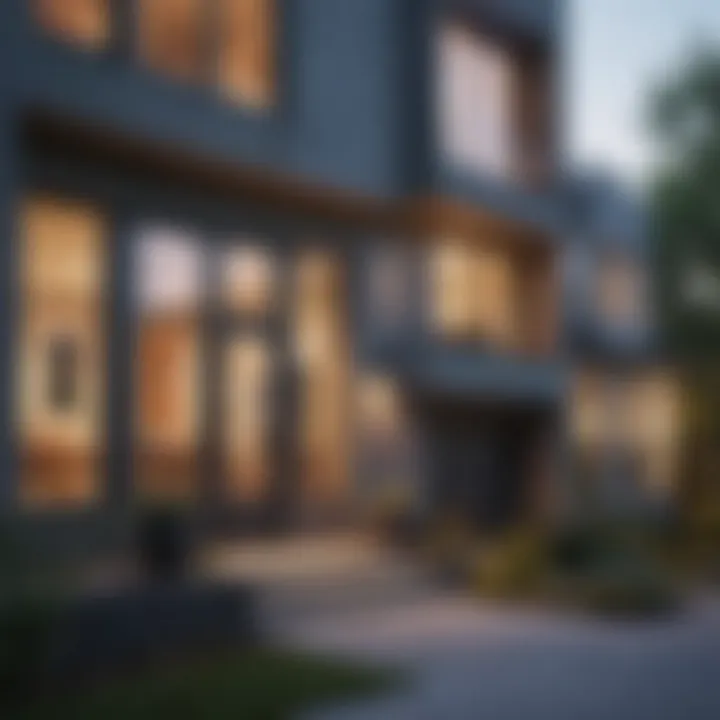
Intro
When choosing a home, potential buyers often face a crucial decision between townhomes and traditional houses. Understanding the nuances between these options is essential for making informed choices, particularly in today's dynamic real estate market. This article lays bare the distinctions with an emphasis on cost, space, maintenance, and community dynamics. We further address design flexibility, investment implications, and lifestyle considerations, arming buyers with the insights needed to navigate their property journey.
Home Design Inspiration
Architectural Styles
The design of townhomes and traditional houses can dramatically shape the living experience. Townhomes are often characterized by their shared walls and compact layout, typically found in clusters or series. They may reflect modern aesthetics or traditional styles but usually prioritize functionality due to space constraints. In contrast, standalone houses typically showcase a broader range of architectural styles, from colonial and Victorian to contemporary designs. This variety allows for more personalized expression.
- Townhomes often feature:
- Traditional houses generally allow for:
- Uniformity in design across units
- Limited outdoor space
- Multi-level layouts often maximizing vertical space
- Unique designs tailored to homeowner preferences
- Larger yards and garden spaces
- Potential for outdoor amenities like pools or patios
Innovative Decor Trends
Beyond architecture, the interior decor also varies greatly between townhomes and traditional houses. Townhomes may lean towards minimalism, as the use of space is paramount. This could include open-plan living areas that maximize light and utility. In contrast, traditional homes provide more space for various decor trends, enabling homeowners to explore styles such as farmhouse, mid-century modern, or bohemian.
Notably:
- For townhomes, popular trends include:
- In traditional houses, trends may showcase:
- Multi-functional furniture
- Neutral color palettes
- Smart home technology integration
- Vintage pieces and heirloom items
- Extensive use of personalization in each room
- Greater emphasis on landscaping and curb appeal
"Design choices largely influence the comfort and functionality of a living space, making them a key consideration in the decision-making process."
Cost Considerations
A critical factor that differentiates townhomes from traditional houses is the financial aspect. Townhomes tend to be more affordable upfront due to their smaller size and shared infrastructure. However, potential buyers must consider homeowners association (HOA) fees, which often cover maintenance and community amenities.
Conversely, traditional houses might demand higher initial investment but can offer larger areas and private lots. Assessing ongoing maintenance costs, property taxes, and potential appreciation should play a significant role in the decision.
Community Living
The sense of community can also vary greatly between these housing options. Townhomes typically foster a closer-knit community due to shared walls and common areas, promoting interaction among residents. Traditional houses, especially in suburban or rural settings, might provide more privacy and space but can result in a less cohesive community experience.
Understanding these nuances helps potential buyers align their personal expectations with their housing choices.
Overall, the decision between a townhome and a traditional house is deeply personal and multifaceted. It requires careful consideration of lifestyle preferences, financial capabilities, and long-term goals.
Intro to Townhomes and Houses
Understanding the distinctions between townhomes and traditional houses is essential for anyone considering a new home purchase or investment. This section sets the framework for the discussions that follow, highlighting key elements that define both housing options.
Townhomes and houses offer unique benefits and considerations tailored to different lifestyles and budgets. Buyers should recognize how these structures impact various aspects of living, such as community involvement, maintenance responsibilities, and financial implications. This foundational knowledge can guide decision-making processes.
Definition of Townhomes
Townhomes are typically multi-story properties that share one or two walls with adjacent homes. They are designed as part of a larger complex or community, providing a distinct architectural style while maintaining proximity to neighbors. Townhomes usually feature small yards or no yards at all, emphasizing low-maintenance living. They appeal to those looking for a blend of community and independence, often found in suburban or urban settings.
Definition of Houses
Traditional houses, often referred to as single-family homes, stand alone on their own lots. They provide more space for outdoor areas, such as gardens and garages. Houses come in various architectural styles and sizes, offering greater flexibility for customization. This type of dwelling tends to offer more privacy and distance from neighbors, which can be a significant factor in lifestyle choices. Homeowners have the option to expand or renovate their properties, adding to their investment potential.
Architectural Differences
Understanding the architectural differences between townhomes and houses is essential for potential buyers or investors. This aspect influences not only the aesthetic appeal but also functionality, energy efficiency, and the overall living experience. By exploring the design and structure of both options, one gains insight into how these physical characteristics affect daily living, potential renovations, and resale value.
Design and Structure of Townhomes
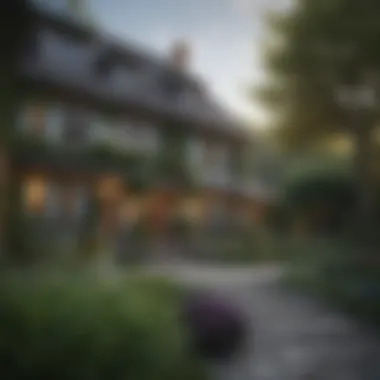
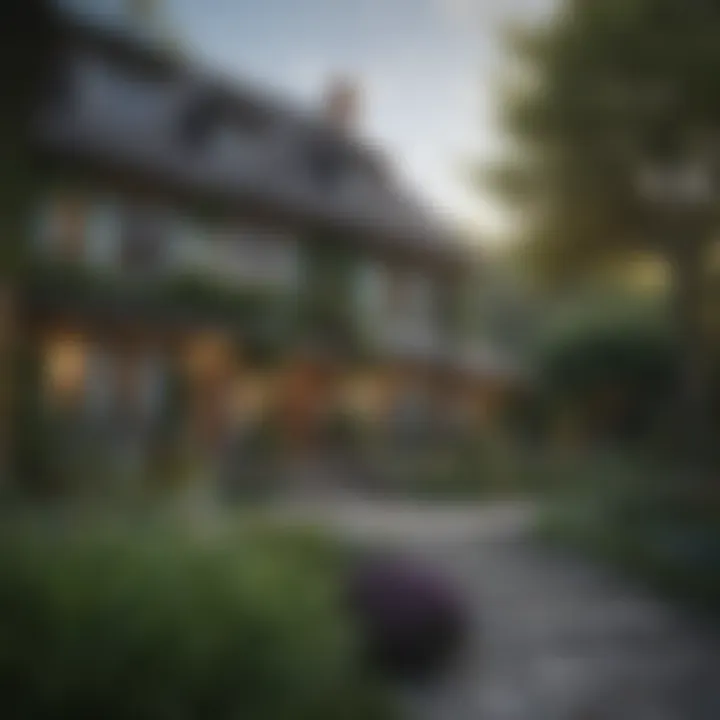
Townhomes usually feature a more compact and linear design. They share walls with adjacent properties, which can lead to more efficient heating and cooling as the shared walls minimize exposure to external temperatures. The architectural approach often includes multiple floors, maximizing vertical space.
Common characteristics of townhomes include:
- Uniform Facades: Townhomes often exhibit a consistent exterior aesthetic within a development, contributing to a harmonious neighborhood appearance.
- Private Entrances: Each unit typically has separate entrances, providing the notion of privacy despite being attached to neighboring homes.
- Limited Outdoor Space: The area around townhomes is often smaller due to shared property lines. Small yards or patio spaces are common, which may restrict outdoor activities or gardening.
These features cater to individuals or families looking for lower maintenance living options without a single-family home’s extensive exterior upkeep.
Design and Structure of Houses
In contrast, traditional houses stand individually on their lots, allowing for greater design flexibility. This independence grants homeowners more autonomy over both the interior and exterior designs. Different architectural styles can be seen across neighborhoods, driven by personal taste and historical influences.
Key attributes of houses include:
- Custom Layouts: Homeowners have the liberty to modify or completely redesign layouts to fit their lifestyle. This can include larger kitchens, additional bedrooms, or even open floor plans.
- Expansive Outdoor Areas: Houses typically feature larger yards, giving families space for outdoor activities, gardens, and privacy.
- Varied Building Materials: Individuals may choose from diverse construction materials, influencing insulation, durability, and energy efficiency.
Understanding these architectural distinctions enables potential residents to align their housing preferences with their lifestyle needs. While townhomes may appeal to those seeking community and reduced maintenance, standalone houses attract those valuing independence and spaciousness.
Space and Layout Considerations
Understanding the space and layout of townhomes and houses is essential for potential buyers. This section examines the differences in square footage and layout variability that can significantly influence one’s living experience. Buyers must consider how these elements impact their lifestyle, mobility, and future needs.
Square Footage in Townhomes
Townhomes typically offer a more compact living space compared to traditional houses. Generally, the square footage of townhomes ranges from 1,200 to 2,500 square feet. This space usually encompasses multiple levels, which can create an illusion of roominess despite the overall smaller footprint compared to standalone houses.
It is also important to note that many townhomes feature shared walls. This design allows for a more efficient use of land and often results in lower costs for both builders and buyers. However, some may find that the proximity to neighbors compromises their sense of privacy. Townhomes may include amenities like small yards, balconies, or shared green spaces, which can enhance living conditions without necessitating large expanses of land.
Square Footage in Houses
In contrast, traditional houses exhibit a wider variety in square footage. Generally, houses start at around 1,500 to 1,800 square feet and can easily exceed 3,000 square feet, depending on the specific designs and layouts. This additional space often translates into separate rooms for various purposes rather than the multi-functional areas that are common in townhomes.
Houses often allocate room for a bigger backyard or garden, allowing for more outdoor leisure activities. This additional square footage gives homeowners more autonomy over their space, presenting options for customization tailored to their lifestyle preferences.
Layout Variability
Layout flexibility is another critical point when comparing townhomes and houses. Townhomes usually come with a defined layout, influenced by their multi-level structure and architectural guidelines. While some floor plans may offer an open-concept feel, changes to the internal layout are generally limited due to the shared walls and structural elements.
On the other hand, houses often provide more versatility in layout decisions. Homeowners can often choose to remodel their interior, making it possible to add rooms, change configurations, or create unique spaces that suit their needs. This kind of customization can be a significant draw for buyers who value creativity and personal expression in their living spaces.
In summary, the examination of space and layout in both townhomes and houses reveals crucial distinctions. While townhomes may appeal to those seeking a low-maintenance lifestyle, houses offer more space for personalization and outdoor activities. As potential buyers weigh their options, understanding these differences can inform their choices accordingly.
Cost Implications
Understanding the cost implications of townhomes and houses is crucial for any potential buyer. Costs are not limited only to the price of purchase but also include maintenance and associated expenses. These factors can significantly affect long-term financial stability. The decision to choose between a townhome and a house can have monetary implications that extend into many areas such as value appreciation, resale value, and recurring costs. It is essential to consider these nuances to make an informed choice that aligns with personal financial situations.
Pricing Trends for Townhomes
Townhomes generally present a more affordable option compared to traditional houses. This lower price point makes them appealing to first-time homebuyers and those looking to downsize. The average price of a townhome varies markedly by location. For instance, in urban settings, the prices can be competitive with smaller houses. Recent trends show that townhomes have seen a steady increase in demand, driven by a high interest in low-maintenance living and smaller spaces.
"Affordability remains a key factor; townhomes often provide valuable features at a fraction of the cost of houses in similar areas."
- Location Matters: Prices can be influenced by local real estate trends.
- Market Conditions: When the housing market is competitive, prices for townhomes may rise faster than houses due to their desirable features.
- Amenities Impact: Townhomes in communities with desirable amenities may command a higher price.
Pricing Trends for Houses
On the other hand, traditional houses tend to carry a higher price tag. They appeal to families looking for more space and privacy. The price of houses is influenced by factors such as location, size, and overall condition. In many regions, houses have traditionally appreciated in value at a steadier rate compared to townhomes. This can make them a more attractive option for long-term investors.
- Size and Functionality: Larger square footage generally means higher costs.
- Resale Potential: Traditional houses often have a greater resale potential due to market demand for single-family homes.
- Market Sentiment: During real estate booms, the prices for houses can spike dramatically, impacting overall market dynamics.
Long-term Investment Considerations
When considering long-term investment, both townhomes and traditional houses offer potential for appreciation. Townhomes may appreciate less in value than houses, but they often require less initial capital. For homeowners primarily interested in stability and low maintenance, townhomes may prove to be a wise investment. Conversely, houses can offer more space and investment opportunities, particularly if located in high-demand areas.
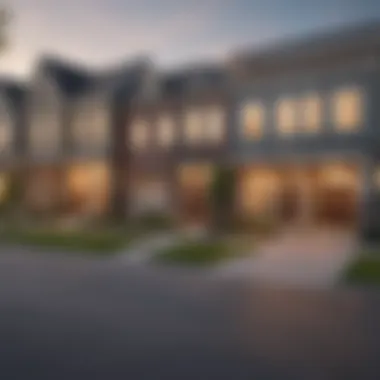
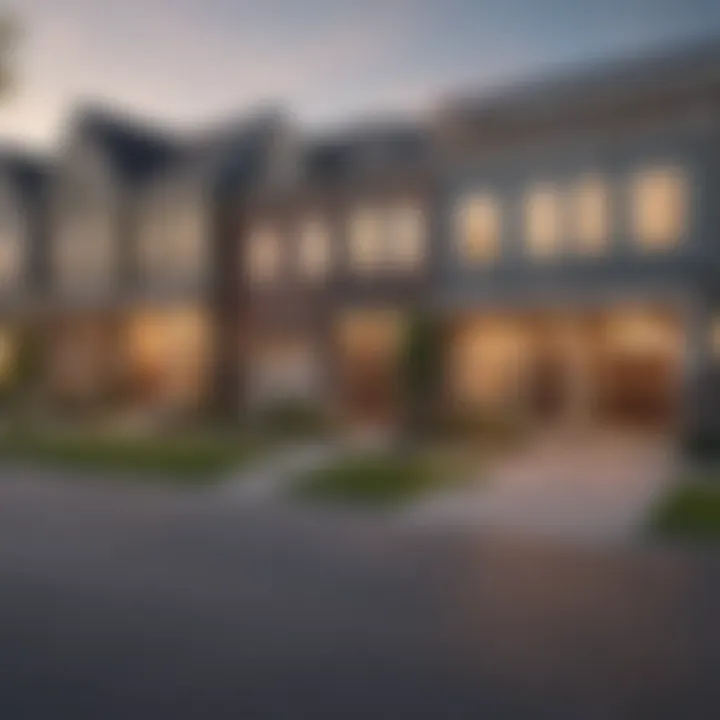
- Consult Market Data: Analyzing historical prices and trends can shed light on potential future value.
- Community Development: Homes in emerging neighborhoods might appreciate faster than those in established areas.
- Cost vs. Benefits: Determine whether the potential long-term benefits justify the initial higher costs.
In summary, the financial implications of choosing between a townhome and a house encompass various factors from initial purchase price to long-term investment potential. Understanding these nuances provides prospective buyers the necessary insights to navigate their decisions effectively.
Maintenance Responsibilities
Understanding maintenance responsibilities is crucial when deciding between townhomes and houses. This aspect often influences the buyer's choice, as different living arrangements come with varying degrees of upkeep required. Maintenance encompasses everything from lawn care to repairs and can significantly impact overall living experience and financial planning.
In townhome communities, maintenance responsibilities typically fall under a homeowners association (HOA). This arrangement can alleviate the burden of tasks such as landscaping, exterior repairs, and common area upkeep, making it an appealing option for those who prefer to invest their time in other pursuits. However, this convenience sometimes comes at a price, as HOA fees can add to monthly living costs and may come with strict guidelines on property alterations and usage.
Conversely, homeowners of standalone houses retain full control over their maintenance duties. This independence means the owner is responsible for all aspects, including yard work, repairs, and overall property management. While this can offer greater freedom in customization, it often requires a significant time commitment and financial investment.
Ultimately, understanding the implications of maintenance responsibilities assists potential buyers in evaluating how much time, money, and effort they are willing to allocate for their living situation.
Maintenance for Townhomes
Townhomes are generally subject to HOA rules, which makes maintenance responsibilities somewhat more manageable. Residents usually enjoy benefits such as:
- Shared Costs: Many townhome communities pool resources to cover common repairs and landscaping, easing the financial burden for individual owners.
- Professional Management: Most HOAs hire professional services to handle routine maintenance tasks like snow removal, lawn care, and maintenance of common areas.
- Minimal Upkeep: The exterior maintenance of a townhome is often limited to the interior space and any small backyard area, making it less demanding than a full house.
However, residents should also be mindful of potential drawbacks. While these associations provide ease in maintenance, they may also impose restrictions that limit personal expression or modifications to the property.
Maintenance for Houses
In contrast with townhomes, owning a standalone house brings a completely different set of maintenance responsibilities. Homeowners must take on:
- Complete Control: Homeowners can modify their property without HOA restrictions, allowing for personal flair and customization.
- Higher Upkeep Requirements: Unlike townhomes, standalone houses require full attention to interior and exterior maintenance, which might involve regular lawn care, roof inspections, and repairs.
- Unplanned Expenses: Homeowners may face unexpected costs due to repairs that cannot be predicted—like plumbing issues or the need for an HVAC update.
While the freedom of maintaining a house may be appealing, it necessitates a higher level of commitment and preparedness for financial implications. Buyers who prioritize flexibility may find standalone homes more attractive, whereas those wanting less maintenance may lean toward townhomes.
Community Living vs. Privacy
The juxtaposition of community living and privacy presents a significant consideration for those deliberating between townhomes and traditional houses. Each option carries distinct implications for social interaction and personal space, which can profoundly affect one’s lifestyle. Understanding these distinctions is essential in making a well-informed decision that suits individual preferences and circumstances.
Social Dynamics in Townhomes
Townhomes frequently emphasize community engagement. They typically feature closer proximity to neighbors, fostering a sense of camaraderie that appeals to many. The design of townhomes often reflects this dynamic, with shared walls and communal facilities like parks or pools, which encourage social activities. Residents might find themselves involved in neighborhood events or associations that enhance connections.
However, while this community aspect offers numerous advantages, potential homeowners should remain aware of the challenges it may pose. Noise from neighbors can be an issue, particularly in thin-walled constructions. Sharing communal spaces also means navigating the dynamics of collective usage. Not all residents may adhere to the same standards of upkeep or noise, possibly leading to tension.
Ultimately, the social environment can be quite lively in a townhome setting. Many find joy in forging relationships and building a support network within their community. But it is essential for prospective buyers to consider their comfort level with these social dynamics.
Privacy in Houses
In contrast, standalone houses prioritize privacy and personal space. Homeowners can create a buffer from neighbors through yards that offer a degree of separation. This layout often translates to less disturbance from noise and more control over one’s environment.
The ability to configure landscapes such as gardens and fences allows for personal expression and enjoyment without the constraints of shared ownership. Here, homeowners can host gatherings, work on hobbies, or simply relax without the concerns common in closer-knit communities.
Yet, this distinctive level of privacy comes with its own set of trade-offs. Often, standalone houses are situated in less densely populated areas where community is less vibrant, potentially leading to feelings of isolation. Homeowners might have fewer opportunities for social interaction unless they consciously seek out ways to engage with the larger community.
In summary, the choice between community living in a townhome and the privacy of a standalone house fundamentally shapes one’s lifestyle. Each option has its unique set of benefits and drawbacks that must align with personal values and objectives.
Outdoor Space and Lifestyle
Outdoor space plays a significant role in the aesthetic and functional appeal of a residence. It affects not only the physical environment but also influences lifestyle choices and community dynamics. For many potential homeowners, the amount and usability of outdoor space can directly correlate with their living comfort and recreational opportunities. This section will explore how townhome and house options contrast in providing outdoor space and reflect broader lifestyle implications.
Yard Space in Townhomes
Townhomes often come with limited yard space compared to traditional houses. The typical townhome features either a small private yard or a shared community area. This can be both a drawback and an advantage. On one hand, smaller yards demand less maintenance and can suit individuals with busy lifestyles. On the other hand, constraints on outdoor space may limit options for gardening, entertaining, or family activities.
Residents in townhomes frequently benefit from accessible community facilities, such as parks or playgrounds, compensating for their own smaller outdoor areas. This communal aspect fosters socialization among neighbors, which can enrich one’s living experience. However, while some may relish the community engagement, others may find it restrictive, especially if they prefer solitude or outdoor privacy.
Yard Space in Houses
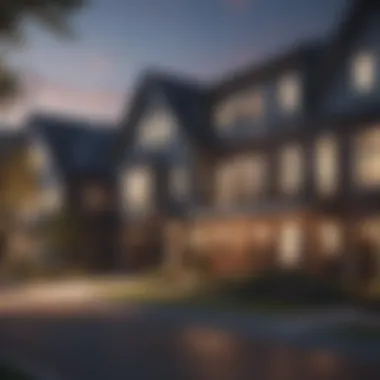
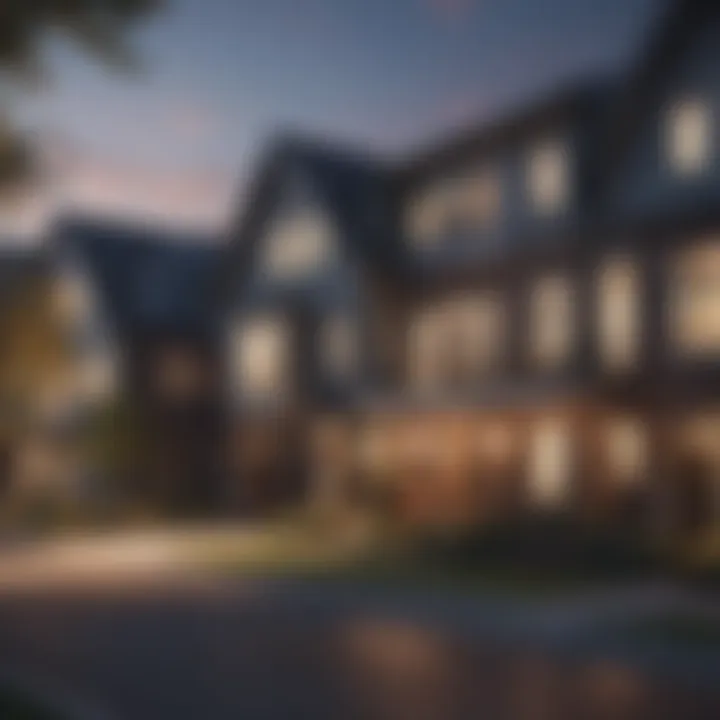
In contrast, houses typically offer yard space that is more expansive and private. Homeowners can enjoy gardens, patios, and plenty of room for recreational activities. The increased outdoor area can be a selling point for families, allowing for play, gardening, and various outdoor gatherings. Such space provides a refuge to retreat, which many find essential for a well-rounded lifestyle.
However, larger yards come with higher upkeep. Regular maintenance tasks can become overwhelming for some, particularly in areas with demanding climates. Homeowners often must allocate time for lawn care, landscaping, and repairs. Ultimately, choosing a house with ample outdoor space may depend on personal lifestyle preferences and commitment to maintenance.
"The choice between a townhome and house often depends not only on space but on one's lifestyle aspirations and readiness to maintain outdoor areas."
Understanding the outdoor space dynamics in townhomes versus houses is vital for prospective buyers. Such insights guide individuals in making informed decisions that align with their values and lifestyle desires.
Market Trends and Future Directions
Understanding market trends and future directions is crucial for potential homeowners and investors. In recent years, there has been growing interest in townhomes, alongside the traditional house. These trends reflect changing preferences in housing, influenced by economic factors and lifestyle choices. This section delves into the reasons behind these movements, as well as potential implications for the housing market.
Growing Popularity of Townhomes
The trend towards townhomes has gained significant momentum. A few reasons contribute to this popularity:
- Affordability: Many see townhomes as a valuable alternative to single-family houses. Generally, they come at lower price points, making them more accessible for first-time buyers.
- Urban Living: There is a shift towards urbanization, with people preferring locations closer to work and amenities. Townhomes often occupy prime locations, facilitating convenient access to urban centers.
- Lower Maintenance: Townhomes usually require less outdoor maintenance compared to houses, which is appealing for individuals who prefer a manageable lifestyle. This aspect resonates particularly well with younger buyers and retirees.
"Townhomes represent a solution to the needs of modern living, merging affordability with accessibility."
More individuals are realizing that townhomes are not merely small houses but offer a community-oriented lifestyle. This change encourages developers to build more townhome complexes that cater to this expanding market segment.
Stability in the Housing Market
While fluctuations are customary in real estate, recent data indicate some stabilization trends in the housing market. Notably, buying a townhome or a traditional house is not impervious to economic pressures, but certain elements contribute to a sense of steadiness:
- Consistent Demand: As stated earlier, townhome demand remains high, even amid economic shifts. Buyers are recognizing their benefits, leading to stable property values over time.
- Diverse Market Options: With more towns and cities developing townhome properties, potential owners have varied choices to consider, which helps in maintaining market health.
- Investment Appeal: Townhomes can be attractive investments. Investors view them as reliable rental options, particularly in urban locales, effectively increasing their desirability.
As the housing market continues to evolve, it is clear that townhomes hold a significant role. Their increasing prevalence and the stability they bring can shape future buying decisions, encouraging prospective homeowners to weigh their options thoughtfully.
Personal Preferences and Lifestyle Choices
The choices individuals make about where to live are deeply influenced by their personal preferences and lifestyle. This aspect plays a significant role in the evaluation of townhomes versus houses. Potential buyers often weigh several factors that align with their values and circumstances. Understanding these preferences is crucial, as they can determine satisfaction with a living arrangement over time.
Evaluating Lifestyle Fit
When considering whether to purchase a townhome or a traditional house, evaluating lifestyle fit is essential. Each option comes with distinct advantages that cater to different lifestyles. Townhomes generally offer a communal lifestyle with shared amenities such as pools or gyms, appealing to those who value connection and convenience. These properties often require less maintenance and can provide a sense of security with nearby neighbors.
On the other hand, houses typically afford greater privacy and space. For families or individuals who value independence and outdoor space, traditional houses might better suit their needs. The yard space available in a house allows for gardens, play areas, or personal retreats. Understanding what fits your lifestyle can significantly affect long-term happiness in a home.
Some elements to contemplate include:
- Social Needs: Do you prefer community interaction or personal space?
- Family Dynamics: Does your family require more space or prefer proximity to neighbors?
- Maintenance Willingness: Are you comfortable handling home upkeep, or would you prefer shared responsibilities?
Long-term Considerations
Long-term living aspirations must also influence the decision between a townhome and a house. Consideration of future plans—such as potential family growth, changes in work-life balance, or shifts in lifestyle—can guide your choice. Owning a home that can adapt to your evolving needs may lead to fewer housing changes in the future.
Additionally, the investment potential of both options requires evaluation. Townhomes may provide a more affordable entry point into the real estate market, but they might appreciate at different rates compared to traditional houses. On the contrary, houses, while often initially more expensive, can offer more extensive renovations and expansions over time.
In summary, assessing personal preferences and lifestyle choices not only helps in making an informed decision but also enhances the overall quality of life in your chosen environment. Aligning your housing choice with your core values and future plans can lead to greater satisfaction and stability.
Culmination
The conclusion of this article serves as an essential summary and reflection on the core themes presented throughout the exploration of townhomes and traditional houses. Throughout this analysis, each aspect has been dissected with focus on cost, space, maintenance, and community living. This final section is crucial as it synthesizes information, empowering potential buyers with a clearer understanding of what each dwelling type offers and what suits their needs best.
Summary of Key Differences
When we compare townhomes and houses, several important differences emerge:
- Architectural Style: Townhomes are often uniform, sharing walls with neighbors, while houses typically stand alone.
- Space and Layout: Townhomes usually have less overall square footage and yard space compared to traditional houses, which might offer more rooms and outdoor areas.
- Maintenance Responsibilities: Homeowners of townhomes often deal with less exterior maintenance due to shared responsibilities, whereas house owners maintain everything on their own.
- Cost Variability: Townhomes may present a lower entry price; however, houses may provide long-term valuation benefits.
- Privacy and Community: While townhomes promote community living, houses offer greater privacy and solitude.
Understanding these distinctions aids in the decision-making process, allowing buyers to align their preferences with their potential purchases.
Final Recommendations
Choosing between a townhome and a house is fundamentally tied to individual lifestyle preferences and future considerations. Here are some recommendations to guide this choice:
- Lifestyle Consideration: Assess your daily needs and whether you value privacy over community engagement. If a social atmosphere is important, a townhome might be preferable.
- Financial Planning: Consider your financial situation. Townhomes can be a sensible option for first-time buyers, while houses may provide better long-term investment potential.
- Future Planning: Think about long-term implications. If you plan to grow your family or desire more outdoor space, a traditional house could be more fitting.
- Market Trends: Keep an eye on local real estate trends. Depending on the market, one option may become more advantageous than the other over time.
Decisions in real estate require careful thought. Understanding the nuances of townhomes versus houses can lead to a more informed and satisfying purchase.







